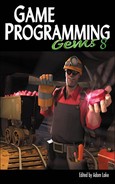Book Description
Welcome to the eighth volume of the must-have reference series for game developers, "Game Programming Gems," the series that helped define the standards for game programming and continues to be an essential source for new, innovative techniques. "Game Programming Gems 8" provides the tools and inspiration that game developers need to excel. Featuring cutting-edge, ready-to-use techniques contributed by industry veterans and experts, this new collection is a key resource for inspiration, insight, and a plethora of time-saving, ready-to-use methods for the developer's tool box! Gems 8 answers the needs of passionate developers, eager newcomers, voracious production requirements, and the demand for innovating and entertaining gameplay. Covering all the key development areas including General Programming, Mathematics, Graphics, Artificial Intelligence, Physics, Networking/Multiplayer, and Audio, each section is edited by an expert in the field to ensure that the ideas are original, accurate, and useful. In this edition, there is even a special segment on General Purpose Programming on GPUs for Game Developers. Dig into this new volume of useful, practical ideas and techniques and get ready to make games that are more inventive, entertaining, and satisfying!
Table of Contents
- Copyright
- Preface
- Acknowledgments
- Contributors
- 1. Graphics
- Introduction
- 1.1. Fast Font Rendering with Instancing
- 1.2. Principles and Practice of Screen Space Ambient Occlusion
- 1.3. Multi-Resolution Deferred Shading
- 1.4. View Frustum Culling of Catmull-Clark Patches in DirectX 11
- 1.5. Ambient Occlusion Using DirectX Compute Shader
- 1.6. Eye-View Pixel Anti-Aliasing for Irregular Shadow Mapping
- 1.7. Overlapped Execution on Programmable Graphics Hardware
- 1.8. Techniques for Effective Vertex and Fragment Shading on the SPUs
- 2. Physics and Animation
- Introduction
- 2.1. A Versatile and Interactive Anatomical Human Face Model
- 2.2. Curved Paths for Seamless Character Animation
- 2.3. Non-Iterative, Closed-Form, Inverse Kinematic Chain Solver (NCF IK)
- 2.4. Particle Swarm Optimization for Game Programming
- A Few Words on Optimization
- The PSO Paradigm and Its Canonical Formulation
- Add-Ons to the Classical Formulation
- A Note on Randomness
- Case Study 1: Typical Benchmarking Functions
- Case Study 2: Optimization of Physical Parameters for In-Game Vehicle Simulation
- Case Study 3: Physics-Based Animation of Mechanical Systems
- Conclusion
- References
- 2.5. Improved Numerical Integration with Analytical Techniques
- Classifying Errors
- Kinematics of Constant Acceleration
- The Kinematic Integrator
- Integral Contributions Due to a Spring Force
- Multiple Forces
- Integral Contributions of a Pulse
- Integral Contributions of Collision Forces
- Integral Contributions of Viscous Forces
- Integral Contributions of Constraint Forces
- Summary
- Conclusion
- 2.6. What a Drag: Modeling Realistic Three-Dimensional Air and Fluid Resistance
- 2.7. Application of Quasi-Fluid Dynamics for Arbitrary Closed Meshes
- 2.8. Approximate Convex Decomposition for Real-Time Collision Detection
- 3. AI
- Introduction
- 3.1. AI Level of Detail for Really Large Worlds
- 3.2. A Pattern-Based Approach to Modular AI for Games
- 3.3. Automated Navigation Mesh Generation Using Advanced Growth-Based Techniques
- 3.4. A Practical Spatial Architecture for Animal and Agent Navigation
- 3.5. Applying Control Theory to Game AI and Physics
- 3.6. Adaptive Tactic Selection in First-Person Shooter (FPS) Games
- 3.7. Embracing Chaos Theory: Generating Apparent Unpredictability through Deterministic Systems
- 3.8. Needs-Based AI
- 3.9. A Framework for Emotional Digital Actors
- 3.10. Scalable Dialog Authoring
- 3.11. Graph-Based Data Mining for Player Trace Analysis in MMORPGs
- 4. General Programming
- Introduction
- 4.1. Fast-IsA
- 4.2. Registered Variables
- 4.3. Efficient and Scalable Multi-Core Programming
- 4.4. Game Optimization through the Lens of Memory and Data Access
- 4.5. Stack Allocation
- 4.6. Design and Implementation of an In-Game Memory Profiler
- 4.7. A More Informative Error Log Generator
- 4.8. Code Coverage for QA
- 4.9. Domain-Specific Languages in Game Engines
- 4.10. A Flexible User Interface Layout System for Divergent Environments
- 4.11. Road Creation for Projectable Terrain Meshes
- 4.12. Developing for Digital Drawing Tablets
- 4.13. Creating a Multi-Threaded Actor-Based Architecture Using Intel® Threading Building Blocks
- 5. Networking and Multiplayer
- Introduction
- 5.1. Secure Channel Communication
- 5.2. Social Networks in Games: Playing with Your Facebook Friends
- 5.3. Asynchronous I/O for Scalable Game Servers
- 5.4. Introduction to 3D Streaming Technology in Massively Multiplayer Online Games
- 6. Audio
- 7. General Purpose Computing on GPUs
- Introduction
- 7.1. Using Heterogeneous Parallel Architectures with OpenCL
- 7.2. PhysX GPU Rigid Bodies in Batman: Arkham Asylum
- Requirements
- Shape Representation
- Dynamics Algorithm
- Pipeline
- Transform Spheres into World Space
- Sphere-Sphere Collision Detection
- Sphere-Mesh Collision Detection
- Evaluate Force Fields
- Calculate Unconstrained Velocities
- Generate Constraints
- Solver
- Update Positions
- GPU Implementation
- CUDA Voxelizer
- Spatial Data Structures
- Solver
- Conclusion
- Acknowledgements
- References
- 7.3. Fast GPU Fluid Simulation in PhysX
- Color Plate
